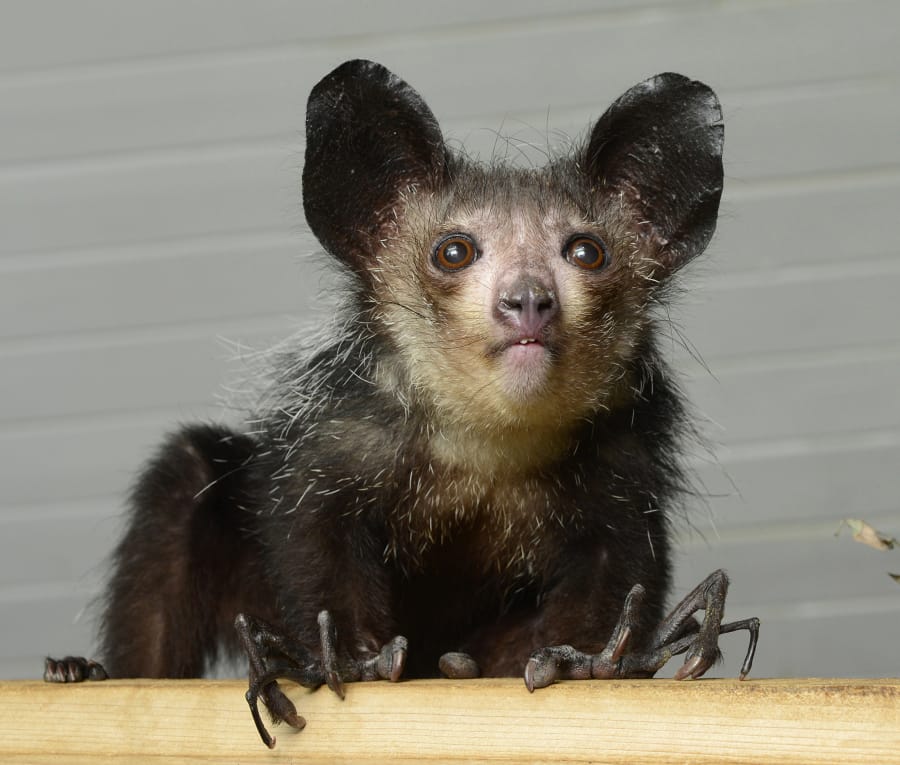Unusual animals called aye-ayes, a species of Madagascan lemur, could have scampered fully formed from Edgar Allan Poe’s forehead. Aye-ayes are primates, like humans and monkeys, but they display a collection of delightfully ghoulish traits. Like rodents, their teeth grow continuously. Two oversize ears, similar to those of bats, adorn their heads. Their hands are stranger still, with slender middle fingers they beat against rotten wood to sense grubs — tapping, tapping, evermore!
Anatomists have discovered a new oddity: Aye-ayes have a tiny sixth finger, a “pseudo-thumb,” that sprouts from their palms, researchers reported Monday in the American Journal of Physical Anthropology.
Lemurs are “weird, isolated primates only found on the island of Madagascar,” said North Carolina State University lemur expert and anatomist Adam Hartstone-Rose, who has studied lemurs since he got a job as a teenager at the American Museum of Natural History.
Aye-ayes combine batlike echolocation with a woodpecker’s appetite for grubs. “They take that long, skinny middle finger and they tap, tap, tap along dead and rotten wood,” Hartstone-Rose said. They also have “the largest brains of any lemurs relative to their body size.” That blend of brainpower, huge ears and acoustic reverberations enables the animals to generate mental maps of hollow spaces within tree trunks.
Once aye-ayes locate a highway of insect tunnels, they bite open a hole in the wood. And into that hole they insert their slender middle fingers, which swivel on ball-and-socket joints. Using a “really long, creepy, needle-y claw,” Hartstone-Rose said, the predators snatch grubs out of their tunnels and drag them to the surface.
The anatomist had dissected hundreds of other primate limbs before he was able to dissect an aye-aye hand. Aye-ayes are very rare. Only about 30 captive aye-ayes live in the United States. Hartstone-Rose dissected aye-aye museum specimens and those that died of natural causes at the Duke Lemur Center in North Carolina, as well as a wild animal that died in Madagascar. “No animal has ever been killed for any of my own research,” he said.
Wild aye-ayes are endangered and their population is decreasing, according to the International Union for Conservation of Nature.
In the aye-aye, Hartstone-Rose and his colleagues were tracing a muscle called the abductor pollices longus, which in humans allows us to stick out thumbs, hitchhiker-style. “This muscle goes from our forearm to the base of our thumb in you, me and essentially every other primate that has ever been documented,” Hartstone-Rose said. As they followed the aye-aye’s muscle, a funny thing happened on the way toward the thumb. A part of the muscle branched off to the aye-aye palm, below the thumb, and connected to a small nub of bone called the radial sesamoid, named after the tiny seed.
Humans do not have these bones on the thumb side of our hands. But if you trace the pinkie edge of your hand, palm-side-up, you can feel a similar bone called the pisiform where your hand meets your wrist. “If you look at the base of your own wrist on the pinkie side, there’s a little pointy-out bone like a little protuberance,” Hartstone-Rose said. That’s a sesamoid bone. Our kneecaps are enlarged sesamoid bones, too.
The bone nub, in the aye-aye, moves in three directions. It has its own fingerprint. The scientists examined six other specimens, using CT scans as well as dissections. All of the aye-ayes had the pseudo-thumbs.
“In some ways, ‘weirdness compounds weirdness’ is the story that’s going on here,” said Matt Borths, a paleontologist at the Duke Lemur Center, who did not participate in the study. (Borths, when reached by phone, was just a few yards away from fossil jaws from an aye-aye ancestor that lived in Egypt 34 million years ago, the oldest known bones belonging to their lineage.)
Borths said the pseudo-thumb hid in plain sight, probably because it was overshadowed by the curiousness of the aye-aye’s other fingers. “Now that we know to look for them, there’s the potential we may find this” adaptation in the fossil record, the paleontologist said. Borths also wants to know more how the aye-ayes use this thumb. “I just want to watch a lot of videos of aye-ayes climbing around,” he said.
The scientists who found the odd thumb suggested this digit evolved to compensate for the aye-aye hands’ extreme specialization. “If you scaled the aye-aye’s arm up to the size of a human arm, their fingers would be about nine inches long, as opposed to yours, which are like three inches,” Hartstone-Rose said. Those oversize fingers aren’t very good at grasping.
Pseudo-thumbs have a special place in evolutionary biology, popularized in Stephen Jay Gould’s 1980 collection of essays “The Panda’s Thumb.” The ancestors of bears and pandas lacked the need for specialized toes on their paws. Their five digits are aligned in a neat and unopposed row. But the pressures of panda existence — a reliance on a diet of tough bamboo — led to their adaptation of sesamoid bones into pseudo-thumbs. They use these thumbs to hold bamboo shoots. Elephants also have elongated sesamoid bones, in their feet, that stabilize their gaits.
Aye-ayes, elephants and pandas are very distantly related mammals. Aye-ayes and pandas converged on the same evolutionary trait through opposite paths: the hyper-specialization of the aye-aye hand and the loss of specialization in bear paws.



